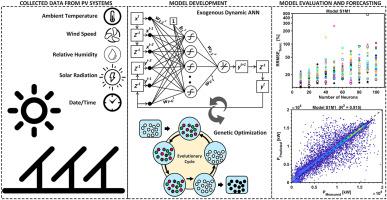Renewable Energy ( IF 9.0 ) Pub Date : 2021-02-20 , DOI: 10.1016/j.renene.2021.02.103 Muhammed A. Hassan , Nadjem Bailek , Kada Bouchouicha , Samuel Chukwujindu Nwokolo

|
Accurate and credible ultra-short-term photovoltaic (PV) power production prediction is very important in short-term resource planning, electric power dispatching, and operational security for the solar power system. This study proposes a novel approach of using genetically optimized non-linear auto-regressive recurrent neural networks (NARX) for ultra-short-term forecasting of PV power output. Hence, the high prediction accuracy of static multi-layered perceptron neural networks can be extended to dynamic (time-series) models with a more stable learning process. Exogenous models with different commonly available meteorological input parameters are developed and tested at five different locations in Algeria and Australia, as case studies of the arid desert climate. The prediction capabilities of the models are quantified as functions of the forecasting horizon (5, 15, 30, and 60 min) and the number of meteorological inputs using various statistical measures. It was found that the proposed models offer very good estimates of output power, with relative root mean square errors ranging between ∼10 and ∼20% and coefficients of determination higher than 91%, while improving the accuracy of corresponding endogenous models by up to 22.3% by only considering the day number and local time as external variables. Unlike the persistent model, the proposed NARX-GA models perform better as the forecasting horizon narrows down, with improvements of up to 58.4%.
中文翻译:

使用遗传优化的非线性自回归递归神经网络的光伏发电超短期外生预测
准确,可靠的超短期光伏(PV)发电量预测在短期资源规划,电力调度和太阳能系统的运行安全性中非常重要。这项研究提出了一种使用遗传优化的非线性自回归递归神经网络(NARX)进行光伏发电超短期预测的新方法。因此,静态多层感知器神经网络的高预测精度可以扩展为具有更稳定学习过程的动态(时间序列)模型。作为干旱沙漠气候的案例研究,在阿尔及利亚和澳大利亚的五个不同地点开发并测试了具有不同常用气象输入参数的外生模型。使用各种统计方法,将模型的预测能力量化为预测范围(5、15、30和60分钟)和气象输入数量的函数。结果发现,提出的模型提供了非常好的输出功率估计,相对均方根误差在〜10%到〜20%之间,确定系数高于91%,同时将相应内生模型的精度提高了22.3%通过仅将天数和本地时间视为外部变量来确定%。与持久性模型不同,拟议的NARX-GA模型随着预测范围的缩小而表现更好,最高可提高58.4%。结果发现,提出的模型提供了非常好的输出功率估计,相对均方根误差在〜10%到〜20%之间,确定系数高于91%,同时将相应的内生模型的精度提高了22.3%通过仅将天数和本地时间视为外部变量来确定%。与持久性模型不同,拟议的NARX-GA模型随着预测范围的缩小而表现更好,最高可提高58.4%。结果发现,提出的模型提供了非常好的输出功率估计,相对均方根误差在〜10%到〜20%之间,确定系数高于91%,同时将相应的内生模型的精度提高了22.3%通过仅将天数和本地时间视为外部变量来确定%。与持久性模型不同,拟议的NARX-GA模型随着预测范围的缩小而表现更好,最高可提高58.4%。











































 京公网安备 11010802027423号
京公网安备 11010802027423号